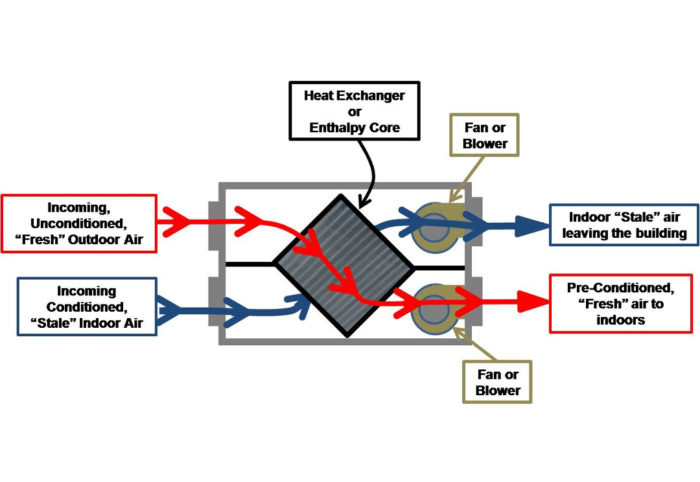Why Use HRV and Its Role in Homes
Wiki Article
Checking out the Perks of Heat Recovery Ventilation for Power Performance in Homes
Heat Recovery Ventilation (HRV) systems provide homeowners a sensible method to improving power efficiency. By redeeming heat from outgoing air, these systems can considerably lower cooling and heating prices. In addition, they supply a consistent supply of fresh air, enhancing interior air high quality and convenience levels. As home owners consider sustainable options, recognizing the nuances of HRV systems becomes increasingly vital. What elements should one evaluate prior to making such an investment?Recognizing Heat Recovery Ventilation Systems

How HRV Enhances Indoor Air Quality

Energy Financial Savings: The Financial Benefits of HRV
Maximizing energy Going Here effectiveness, heat recovery ventilation (HRV) systems offer significant monetary advantages for home owners. By recovering and reusing warmth from exhaust air, HRVs noticeably decrease heating & cooling costs. This technology can lead to power savings of up redirected here to 30%, depending upon environment and usage patterns. Home owners commonly see minimized utility costs shortly after setup, making HRVs a financially wise financial investment with time. Additionally, many areas offer rewards or discounts for energy-efficient upgrades, additionally enhancing the monetary appeal. As energy prices remain to increase, the cost-effectiveness of HRVs becomes increasingly clear. Generally, the unification of HRV systems not just promotes power performance but additionally contributes to lasting financial savings for families.The Environmental Impact of Heat Recovery Ventilation
A considerable ecological benefit of heat recovery ventilation (HRV) systems hinges on their ability to minimize general energy usage. By reclaiming warmth from exhaust air and transferring it to incoming fresh air, HRV systems reduce the requirement for energy-intensive home heating and cooling down methods. This reduction in power need adds to decrease greenhouse gas exhausts, as less nonrenewable fuel source is needed to keep comfy indoor temperatures. Furthermore, HRV systems enhance indoor air high quality by efficiently trading stale air with fresh outside air, reducing dependence on mechanical cooling systems that can hurt the environment. In general, the application of HRV systems supports sustainable living techniques and straightens with international initiatives to combat climate modification by promoting power performance in household setups.
Selecting the Right HRV System for Your Home
How can property owners ensure they choose the appropriate heat recovery ventilation (HRV) system for their needs? First, they ought to analyze their home's size and layout, as these factors influence air flow demands. Next off, examining the system's performance scores is essential, as higher ratings indicate far better efficiency and power cost savings. House owners must additionally take into consideration setup and maintenance costs, contrasting various brand names and designs for worth. In addition, it is very important to examine noise levels, as some systems run even more quietly than others. Consulting with cooling and heating experts can offer customized referrals based on particular home conditions. Taking a look at user reviews and guarantees can help in making an informed decision, guaranteeing that the picked HRV system properly improves interior air quality and power performance.Frequently Asked Questions

Exactly how Frequently Should I Tidy or Preserve My HRV System?
The frequency of cleansing important site or keeping a heat healing ventilation (HRV) system generally depends on usage and ecological aspects. Generally, it is suggested to carry out upkeep every six months to assure peak performance and air quality.
Can HRV Solutions Aid Decrease Humidity Levels Indoors?
HRV systems can efficiently decrease interior moisture levels by trading stagnant, damp air with fresh, drier air from outdoors. HRV Heat Recovery Ventilation. This procedure helps preserve a well balanced indoor setting, enhancing convenience and avoiding moisture-related problems
What Is the Life-span of a Typical HRV System?
The life expectancy of a regular heat recovery ventilation (HRV) system varies, normally lasting between 10 to 15 years. Regular maintenance can prolong its performance and operational life, guaranteeing peak performance throughout its use duration.Are There Any Type Of Noise Problems With HRV Systems?
Noise worry about HRV systems can occur, especially from follower procedure. Numerous contemporary systems are made to decrease sound levels, guaranteeing they run silently while maintaining performance, which deals with possible disruptions in living atmospheres.Can I Mount an HRV System Myself, or Do I Need a Professional?
The individual contemplated whether to set up the heat recovery ventilation (HRV) system directly or employ a professional. Usually, while do it yourself installment is possible, know-how assurances proper capability and compliance with regional structure codes, improving system efficiency.Report this wiki page